
Architectural eye candy right here with this incredible collection of 41 fabulous Belgian castles, chateaus, palaces and manor houses. For a smallish country in size, it sure offers abundance in fabulous architecture.
Frankly, other than ruins, I’d take any one of these for my house. I’m not sure I’d love the upkeep bill, but it sure would be neat to live in one of these spectacular structures.
1. Alden Biesen Castle

Located in the small village of Rijkhoven in the municipality of Bilzen in the province of Limburg, Belgium, the Alden Biesen Castle was constructed in the 11th century by the knights of the Teutonic Order. However, the current buildings were constructed between the 16th and 18th centuries and served as the headquarters of a bailiwick or province of the Teutonic Order. In March 1971, the castle was burned down and then acquired by the Belgian government and restored the property. Today, it serves as a cultural centre and conference centre.
About the Alden Biesen castle
- Where: Limburg, Belgium
- When: 11th century
- Who built it: Knights of the Teutonic Order
- Style: Renaissance style
- What is it now? Open to public / Cultural centre / Conference centre
- Current owner: Belgian state government
2. Arenberg Castle

Located near Leuven in Belgium, Kasteel van Arenberg was the castle of the lords of Heverlee since the 12th century until the family went bankrupt and had to sell the property to the Croÿ family from Picardy in the 15th century. Antoine I de Croÿ demolished the medieval castle to replace a new one, which was completed by his grandson, William de Croÿ in the 16th century. Upon the death of the last duke Charles III of Croy, the château was passed to the Arenberg family until the First World War, then later on became property of the Belgian government and is now open to the public.
About the Arenberg Castle
- Where: Leuven, Belgium
- When: 12th century
- Who built it: Lords of Heverlee
- Style: Medieval architecture / Renaissance style / Gothic style / Neo-gothic style
- What is it now? Open to public
- Current owner: Belgian government
3. Beersel Castle

Beersel Castle was built in the early 14th century by Godfrey of Hellebeek as a defensive base for Brussels. It is located in the Belgian town of Beersel, Flemish Brabant and it was damaged during the war of succession of Brabant. Although it was repaired shortly after, it was once again destroyed during the rebellion against Maximilian of Austriaand was restored after the war. Today, the castle is open to the public owned by the Royal Association of Historic Residences and Gardens in Belgium.
About the Beersel castle
- Where: Leuven, Belgium
- When: 14th century
- Who built it: Godfrey of Hellebeek
- Style: Neo-gothic style
- What is it now? Open to public
- Current owner: Royal Association of Historic Residences and Gardens in Belgium
4. Château de Belœil

Château de Belœil or Beloeil castle became property of the Ligne family in 1394. It is set in the municipality of Belœil in the province of Hainaut, Belgium and has been the residence of the Prince de Ligne since the 14th century. Although the Ligne family still owns the property, it is currently open to the public.
About the Beloeil castle
- Where: Belœil, Belgium
- When: 14th century
- Who built it: Unknown
- Style: Medieval architecture / Baroque style
- What is it now? Open to public
- Current owner: Ligne family
5. Borluut Castle

The Castle Borluut located in village of Saint-Denis-Westrem, Belgium was first mentioned in the Sint-Pieters loan book in 1411. It is said to have remained in the hands of the Borluut family until 1744 came after sale in 1858 in the possession of the family of Count Balthazar Borluut d’Hoogstraete. The owner had it remodeled into a summer residence using architect Joseph Van Damme’s design. The last private owners, Jonkheer Mertens de Wilmars and his wife Suzanne Morel de Boucle Saint-Denis sold the castle to the municipality of Sint-Denijs-Westrem, which later became the property of the city of Ghent. Now, the castle is open to the public.
About the Borluut castle
- Where: Saint-Denis-Westrem, Ghent, Belgium
- When: 15th century
- Who built it: Unknown
- Style: Neo-classical style
- What is it now? Open to public
- Current owner: City of Ghent, Belgium
6. Bornem Castle

Bornem Castle located in Bornem, province of Antwerp, Belgium is a now a country house that is formerly a castle. It is also known as the Marnix de Sainte-Aldegonde Castle, which was built probably in the 10th century to defend against the incursions of the Vikings. The later castle was built during the 16th century in the orders of the Spanish nobleman Pedro Coloma, 3rd Baron of Bornhem and lord of Bobadilla. It was later on became property of the family de Marnix de Sainte-Aldegonde and was renovated by the architect Henri Beyaert at the end of the 19th century. Today, the property houses a museum and is open to the public under the owner, John de Marnix de Sainte-Aldegonde, 14th Earl of Bornem.
About the Bornem Castle
- Where: Bornem, Antwerp, Belgium
- When: 10th century
- Who built it: Unknown / Renovated by architect Henri Beyaert
- Style: Renaissance revival style
- What is it now? Museum / Open to public
- Current owner: House of Marnix de Sainte-Aldegonde
7. Castle de la Faille

Castle de la Faille is a Neo-gothic castle in Bruges, Belgium. It was built in the 19th century by Charles De Wulf for a florist Leon De Wulf, who served in the executive board of the municipal of Bruges. In the 20th century, the castle was purchased by the city of Bruges and became a protected monument.
About the Castle de la Faille
- Where: Bruges, Belgium
- When: 19th century
- Who built it: Charles De Wulf / Leon De Wulf
- Style: Neo-gothic style
- What is it now? Protected monument
- Current owner: Municipality of Bruges, Belgium
8. Castle Gravensteen

The Gravensteen means “castle of the count” in Dutch. It is located in Ghent, Belgium and was originally built as a fortified medieval bastion in the 9th century. The current castle was built in the 12th century by count Philip of Alsace on the same location as the medieval bastion. It was then abandoned in the 14th century after serving as the seat of the Counts of Flanders. In the 19th century, the city of Ghent renovated and restored the castle to its original form after purchasing the property. Now, the Gravensteen serves as the most important tourist attraction of Ghent.
About the Castle Gravensteen
- Where: Ghent, Belgium
- When: 12th century
- Who built it: Philip of Alsace
- Style: Medieval architecture / Gothic style / Renaissance style
- What is it now? Tourist site
- Current owner: City of Ghent, Belgium
9. Harzé Castle

The Harzé Castle located in the municipality of Aywaille, province of Liège, Belgium was built in the 14th century by the Clermont family, originally as a fortress. The castle was erected on the same spot and changed owners multiple times. During World War 2, the castle became the headquarters of the US 18th Airborne Corps under the command of Major General Matthew B. Ridgway during the Battle of the Bulge. Today, the castle serves as a hotel, restaurant, conference center & wedding venue.
About the Harzé Castle
- Where: Aywaille, Liège, Belgium
- When: 14th century
- Who built it: Clermont family
- Style: Renaissance style
- What is it now? Hotel and Restaurant
- Current owner: Private owner
10. Castle of Durbuy

The castle of Durbuy’s history dates back to the 9th century and was owned by John I, Count of Luxembourg and King of the Bohemia. The castle underwent destruction many times and in the 18th century, the castle was bought by the family d’Ursel and had it rebuilt. Today, the castle is still private property and is not open to the public.
About the Castle of Durbuy
- Where: Durbuy, Luxembourg, Belgium
- When: 9th century / Rebuilt in 18th century
- Who built it: Count of Luxembourg / King of the Bohemia
- Style: Renaissance style
- What is it now? Private property
- Current owner: Private owner
11. Annevoie Castle

Annevoie Castle was built in the 18th century in the village of Annevoie-Rouillon in the municipality of Anhée, province of Namur, Belgium. It was constructed in the orders of the Montpellier family and made popular by the extensive water gardens that surround it, the Jardins d’Annevoie, the only ones of their kind in Belgium. It was occupied by the Montpellier family until year 2000 when it was sold to businessman Stephan Jourdain. Today, it is open to the public as a popular tourist site partially owned by the Walloon Region.
About the Castle of Annevoie
- Where: Annevoie-Rouillon, Anhée, Belgium
- When: 17th century
- Who built it: Montpellier family
- Style: French Renaissance style
- What is it now? Tourist site / open to the public
- Current owner: Walloon Region
12. Groot-Bijgaarden Castle


Groot-Bijgaarden Castle was built for Almaric Bigard, the first lord of Bigard in the 12th-century. It is located in Groot-Bijgaarden in the municipality of Dilbeek, Flemish Brabant, Belgium. The castle has been succeeded by 40 owners and today operates as an event venue.
About the Castle of Groot-Bijgaarden
- Where: Groot-Bijgaarden, Belgium
- When: 12th century
- Who built it: Almaric Bigard
- Style: Flemish Renaissance style
- What is it now? Event venue
- Current owner: Private owner
13. Castle of Havré

The counts of Flanders and Hainaut have had control over Havré since the 11th century but the origins of the Havré Castle can be only traced back to the year 1226. However, the castle that is known today was built on the remains of a 12th century feudal fortress, which welcomed many succeeding owners. The castle has been abandoned starting in the early years if the 20th century and is still owned by the Province of Hainaut.
About the Castle of Havré
- Where: Hainaut, Belgium
- When: 12th century
- Who built it: Unknown
- Style: Medieval architecture
- What is it now? Ruined castle
- Current owner: Province of Hainaut
14. Ham-sur-Heure Castle

The Ham-sur-Heure Castle is a gothic style castle located in Ham-sur-Heure, a village in the municipality of Ham-sur-Heure-Nalinnes, province of Hainaut, Belgium. Its history can only be traced back to the 13th century when it was still a property of the Condé family. However, during the 15th century, owned by the d’Enghien family and when the last family member died without heirs, the property was transfered to the De Merode family, and later on to the descendants of Charles John d’Oultremont. The family sold the castle to the municipality of Ham-sur-Heure-Nalinnes, who used it as the town hall.
About the Castle of Ham-sur-Heure
- Where: Ham-sur-Heure-Nalinnes, Belgium
- When: 13th century
- Who built it: Unknown
- Style: Gothic style
- What is it now? Town hall
- Current owner: Municipality of Ham-sur-Heure-Nalinnes
15. Jehay-Bodegnée Castle

Jehay Castle or Jehay-Bodegnée Castle is located in the municipality of Amay in the province of Liège in Belgium. The castle that is known today was built during the 12th century, but it is believed that there was a first castle built in the same location. It was owned by several noble families and survived many damages before it was acquired by the the province of Liège in 1999. Today, the castle serves as a national museum and can be visited for a fee.
About the Castle of Jehay
- Where: Liège, Belgium
- When: Unknown
- Who built it: Unknown
- Style: Gothic style / Gothic revival style
- What is it now? National museum
- Current owner: Province of Liège
16. Castle of the Dukes of Brabant
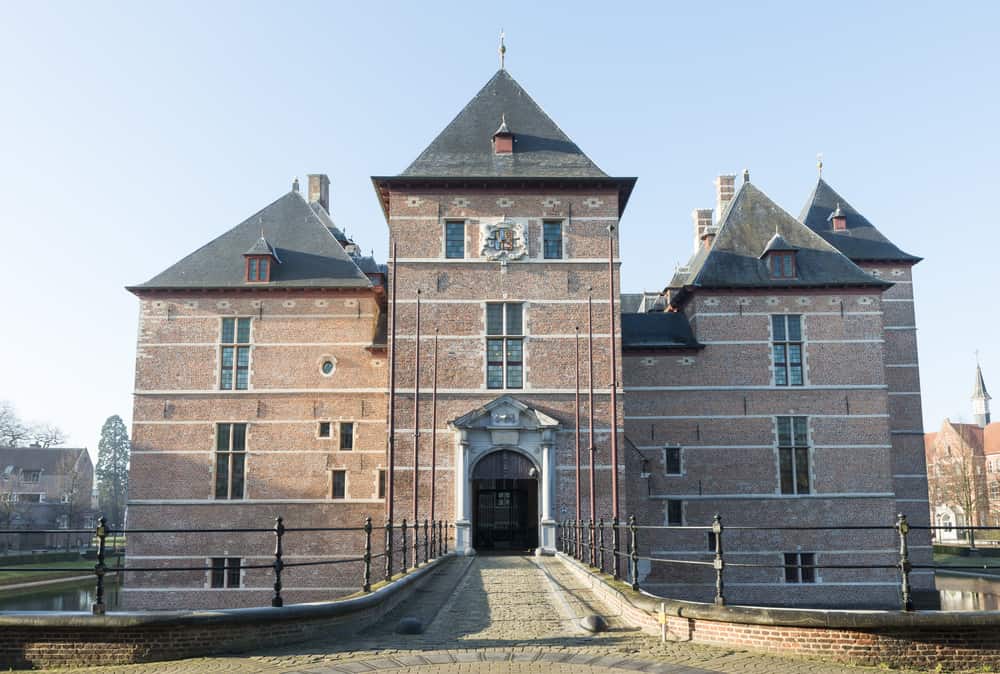

The castle of the Dukes of Brabant located in Turnhout, Belgium originated as a hunting lodge of the first duke of Brabant back in the 12th century. It was rebuilt by Mary of Hungaryat that time the governors of the Netherlands into the known castle of today to serve as the court of pleasure. During the early days of the 20th century, the castle was purchased by the county government and restored in neo-baroque style following the designs of Jules Taeymans. Today, the castle is recognized as a national monument and current serves as a court of justice.
About the Castle of the Dukes of Brabant
- Where: Turnhout, Belgium
- When: 12th century / Reconstructed in the 20th century
- Who built it: First duke of Brabant / Reconstructed by Jules Taeymans
- Style: Medieval castle / Neo-baroque style
- What is it now? National monument / Court of Justice
- Current owner: Government of Belgium
17. Chateau de La Hulpe

The Chateau de La Hulpe, also known as Solvay Castle is located in the municipality of La Hulpe, Walloon Brabant, Belgium. It was built in the 19th century in Flemish Neo-renaissance style by Belgian architect Jean-François Coppens and Jean-Jacques Arveuf-Fransquin of France in the orders of the Marquis Maximilien de Béthune. The castle was acquired by Ernest Solvay during the late 19th century and the property was renamed into the Solvay Castle. Today the property is owned by the government of Wallonia and is open to the public and classified as an “Exceptional Heritage Site in Wallonia.”
About the Chateau de La Hulpe
- Where: Walloon Brabant, Belgium
- When: 19th century
- Who built it: Belgian architect Jean-François Coppens and Jean-Jacques Arveuf-Fransquin of France for Marquis Maximilien de Béthune
- Style: Flemish Neo-renaissance style
- What is it now? Open to the public / Exceptional Heritage Site in Wallonia
- Current owner: Regional government of Wallonia
18. Chateau Freÿr

The castle of Freÿr was built in the middle ages as a keep located in Hastière, Belgium. The keep was given in fief by the Count of Namur to Jean de Rochefort Orjol in 1378 and in 1554, the original keep was destroyed by the French during the wars against Emperor Charles V. It was then rebuilt in the following years into the castle that is known today in a Renaissance Mosane style. The castle’s garden was added in 1760 by Canon Guillaume de Beaufort-Spontin following the designs of André Le Nôtre. Today, the castle’s garden is open to the public while the castle itself is still inhabited by the descendants of the Dukes of Beaufort-Spontin, which became the castle’s lords in the 18th century.
About the Chateau Freÿr
- Where: Hastière, Belgium
- When: 14th century
- Who built it: Unknown
- Style: Medieval architecture / Renaissance Mosane style / French Renaissance style
- What is it now? Open to the public / House of the Dukes of Beaufort-Spontin
- Current owner: Dukes of Beaufort-Spontin
19. Vianden Castle
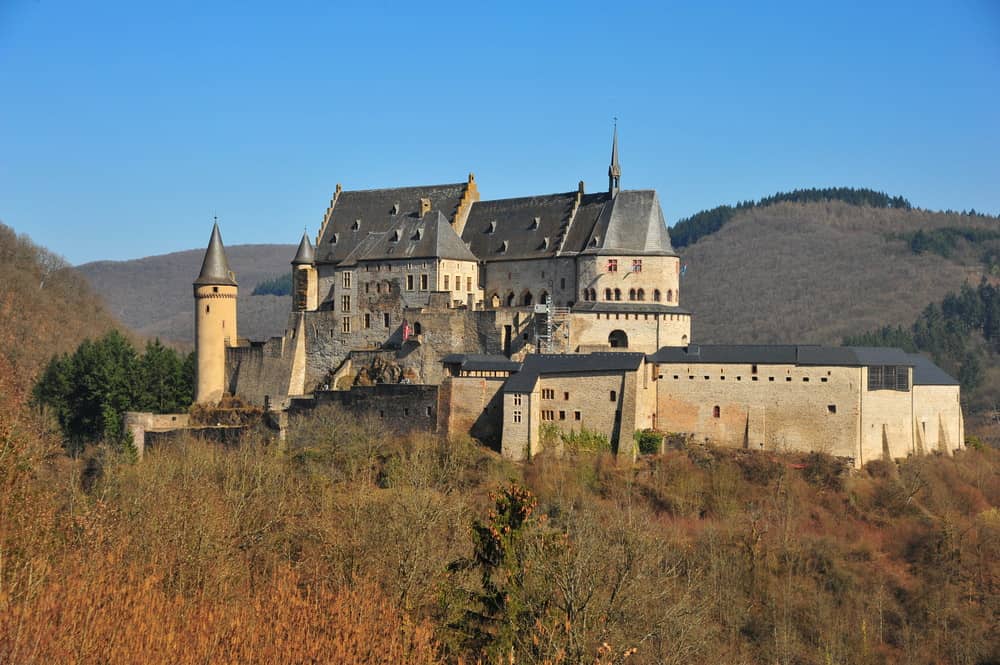
Located in Vianden in the north of Luxembourg, the Vianden Castle is one of the largest fortified castles in the west of the Rhine. It was built in the Romanesque style in the 11th century and was followed by trimmings and Gothic style transformations and in the 17th century, a renaissance style mansion was added after the castle fall into ruins, but later was fully restored later on. Today, the castle is open to the public while guided tours are available.
About the Chateau of Vianden
- Where: Luxembourg, Belgium
- When: 11th century
- Who built it: Unknown
- Style: Romanesque style / Gothic style / Renaissance style
- What is it now? Open to the public / Tourist site
- Current owner: Government of Belgium
20. Crupet Castle

Crupet Castle, also known as Carondelet Castle dates back to the 11th or 12th century as a medieval moated donjon or fortified farmhouse. It is located in the village of Crupet, since 1977 part of the municipality of Assesse, province of Namur, Belgium. During the 16th century, it was transformed into renaissance style castle farm. It is currently a private property and is not open to the public.
About the Crupet castle
- Where: Crupet, Namur, Belgium
- When: 11th century
- Who built it: Unknown
- Style: Renaissance style
- What is it now? Private property
- Current owner: Private owner
21. Gaasbeek Castle

Gaasbeek Castle, located in Gaasbeek, Belgium, has a rich history dating back to the Middle Ages. The castle was constructed during the Middle Ages and later underwent significant renovations during the Renaissance period. Originally a fortified keep, Gaasbeek Castle underwent transformations throughout history. In the 14th century, it was rebuilt into a castle in the medieval architectural style. During the Renaissance, it underwent further renovations, adopting elements of the Renaissance style. Today, Gaasbeek Castle is open to the public and serves as a museum, allowing visitors to explore its historic rooms, impressive art collections, and beautifully landscaped gardens.
About Gaasbeek Castle:
- Where: Gaasbeek, Belgium
- When: Middle Ages / Renaissance period
- Who built it: Unknown
- Style: Medieval architecture / Renaissance style
- What is it now? Open to the public / Museum
- Current owner: Flemish Community (Vlaamse Gemeenschap)
22. Geeraard the Devil Castle

Geeraard, the Devil Castle, situated in Geraardsbergen, Belgium, has a storied past that dates back to the 13th century. The castle’s imposing Gothic style is characterized by its pointed arches, intricate tracery, and vertical emphasis. Today, Geeraard the Devil Castle is open to the public, offering visitors a chance to explore its rich history and experience the ambiance of the Middle Ages.
About Geeraard the Devil Castle:
Where: Ghent, Belgium
When: 13th century
Who built it: Unknown
Style: Gothic architecture
What is it now? Open to the public / Tourist attraction
Current owner: Private owner
23. Het Steen Castle

Het Steen Castle, situated in Antwerp, Belgium, boasts a long and storied history dating back to the 12th century. The castle’s architecture is a testament to medieval design, featuring sturdy walls, defensive towers, and a formidable presence. It stands as a symbol of Belgium’s rich architectural heritage and the strategic importance of the castle during ancient times. Today, Het Steen Castle is open to the public and serves as a captivating tourist attraction.
About Het Steen Castle:
- Where: Antwerp, Belgium
- When: 12th century
- Who built it: Unknown
- Style: Medieval architecture
- What is it now? Open to the public / Tourist attraction
- Current owner: Belgian Government
24. Lavaux-Sainte-Anne Castle


Lavaux-Sainte-Anne Castle, located in Lavaux-Sainte-Anne, Belgium, has a captivating history that dates back to the 15th century. The castle’s architectural style blends medieval and Renaissance influences, reflecting the transitions and renovations it has undergone over the centuries. With its strong stone walls, imposing towers, and elegant details, the castle stands as a testament to the craftsmanship of the time. Today, Lavaux-Sainte-Anne Castle is open to the public and serves as a museum, offering visitors a glimpse into the past. Exploring its historic
About Lavaux-Sainte-Anne Castle:
- Where: Lavaux-Sainte-Anne, Belgium
- When: 15th century
- Who built it: Unknown
- Style: Medieval architecture / Renaissance style
- What is it now? Open to the public / Museum
- Current owner: Wallonia (Regional Government)
25. Le Chateau de Rumbeke

Le Château de Rumbeke, situated in Rumbeke, Belgium. Rumbeke Castle is situated at an altitude of 25 meters. Throughout its history, the castle has witnessed various renovations and modifications, reflecting the architectural trends of different eras. Its medieval foundations are evident in the sturdy stone walls and defensive features, while Renaissance influences can be seen in the elegant details and refined aesthetics. Today, Le Château de Rumbeke is open to the public and is a museum and tourist attraction.
About Le Château de Rumbeke:
- Where: Rumbeke, Belgium
- When: Renaissance period
- Who built it: Unknown
- Style: Medieval architecture / Renaissance additions
- What is it now? Museum / Tourist attraction
- Current owner: Government of Belgium
26. Loppem Castle

Loppem Castle, located in Loppem, Belgium, is a magnificent example of Neo-Gothic architecture. It was constructed in the 19th century by Baron Charlhistorical and cultural significance placece that would reflect the medieval splendor of the past. The castle’s imposing structure, with its pointed arches, soaring towers, and intricate stone carvings, captures the essence of the Neo-Gothic style. Today, it has been transformed into a museum and tourist attraction, allowing visitors to explore its opulent interiors and learn about its rich heritage.
About the Loppem Castle:
- Where: Loppem, Belgium
- When: 19th century
- Who built it: Baron Charles van Caloen
- Style: Neo-Gothic architecture
- What is it now? Museum / Tourist attraction
- Current owner: Jean van Caloen Foundation
27. Manor House of Lac Orval

The Manor House of Lac Orval, situated in Orval, Belgium. The Manor House of Lac Orval showcases the distinctive characteristics of the Neoclassical style. This architectural movement drew inspiration from the classical designs of ancient Greece and Rome, emphasizing symmetry, clean lines, and a sense of proportion. The manor’s facade features grand columns, ornate pediments, and a harmonious arrangement of windows and doorways. Its stately presence and meticulous detailing create a captivating sight for visitors and evoke a sense of refined beauty. Manor House of Lac Orval is not open to the public.
About Manor House of Lac Orval:
Where: Orval, Belgium
When: Unknown
Who built it: Unknown
Style: Neoclassical architecture
What is it now? Private property
Current owner: Unknown
28. Marnix Castle


Marnix Castle, located in Bornem, Belgium, the earliest fortification on the site was of the 10th or 11th centuries and was intended to defend against the incursions of the Vikings. Its design and craftsmanship are testaments to the artistic and architectural achievements of the era. Constructed during the Renaissance period, Marnix Castle showcases the characteristic features of this influential architectural style. Renaissance architecture sought to revive the classical elements of ancient Greek and Roman design while incorporating new artistic techniques and aesthetic principles. Today, Marnix Castle is a privately owned property, offering its owners a sense of exclusivity and privacy.
About Marnix Castle:
- Where: Bornem, Belgium
- When: 10th/11th centuries
- Who built it: Unknown
- Style: Renaissance architecture
- What is it now? Private property
- Current owner: Marnix de Sainte-Aldegonde
29. Ooidonk Castle


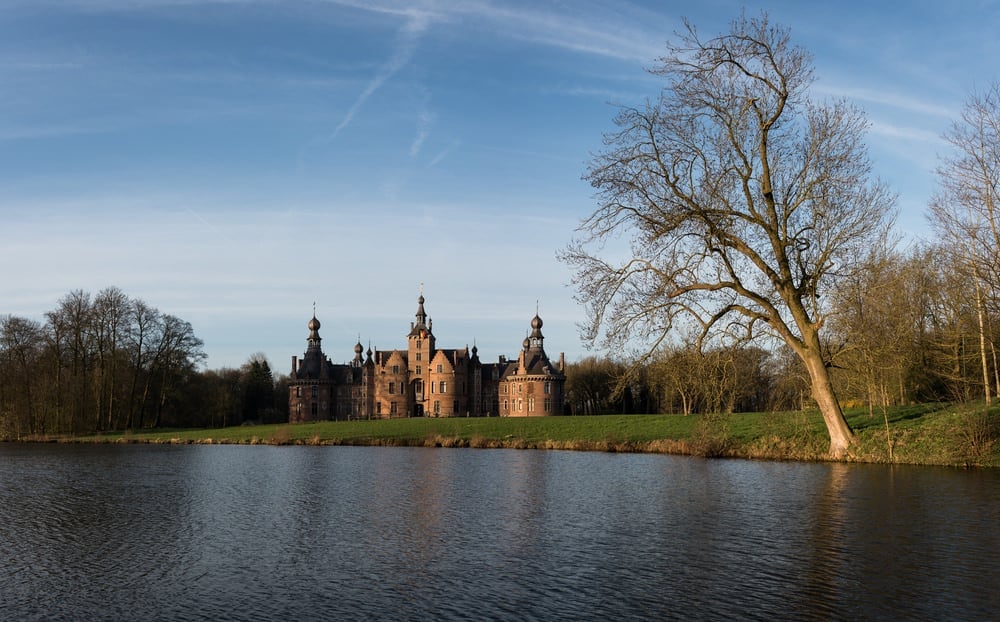
Ooidonk Castle, situated in Bachte-Maria-Leerne, Belgium, is a magnificent example of Flemish Renaissance architecture dating back to the 16th century. Constructed during the Flemish Renaissance period, Ooidonk Castle exhibits the characteristic features of this architectural style. Today, it stands as a remarkable testament to the history and cultural heritage of the region. Parts of the castle are privately inhabited, and certain sections are open to the public, allowing visitors to explore its fascinating interiors and experience the grandeur of the past.
About Ooidonk Castle:
- Where: Bachte-Maria-Leerne, Belgium
- When: 16th century
- Who built it: Unknown
- Style: Flemish Renaissance architecture
- What is it now? Open to the public / Private residence
- Current owner: Count Henry t’Kint de Roodenbeke
30. Poeke castle


Poeke Castle, located in the town of Poeke, Belgium, has a rich history that dates back to the 12th century. It is unknown when the first fortification was constructed at Poeke, but references to it appear from 1139 onwards. The castle played a prominent role during the conflict between Count Louis II of Flanders and the city of Ghent in 1382. In the same year, Eulaard II of Poeke died at the battle of Beverhoutsveld when he attempted to stop the Ghent militia, who had already taken his fort by then. The castle’s architectural style evolved over the centuries, reflecting different eras’ changing tastes and trends. Today, Poeke Castle serves a dual purpose. It is open to the public, allowing visitors to explore its majestic interior and appreciate its architectural splendor. Additionally, Poeke Castle functions as a private residence, exuding an air of exclusivity and offering a glimpse into the life of the present-day owners.
About Poeke Castle:
- Where: Poeke, Belgium
- When: 12th century
- Who built it: Unknown
- Style: Gothic architecture / Neoclassical style
- What is it now? Open to the public
- Current owner: Property of the Municipality of Aalter
31. Ravenhof Manor House in Stabroek

Ravenhof Manor House, located in Stabroek, Belgium, is an exquisite example of Baroque architecture. The precise identity of its original builder remains unknown, adding an air of intrigue to its historical legacy. Constructed during the height of the Baroque period, Ravenhof Manor House showcases the opulence and grandeur associated with this architectural style. The manor house’s distinctive features include elaborate ornamentation, symmetrical façades, graceful curves, and intricate details that exemplify the elegance and splendor of the Baroque aesthetic. Today, the manor house stands as a testament to the region’s rich cultural and historical significance.
About Ravenhof Manor House:
- Where: Stabroek, Belgium
- When: Unknown
- Who built it: Unknown
- Style: Baroque architecture
- What is it now? Open to the public
- Current owner: Municipality of Stabroek
32. Royal Palace of Brussels
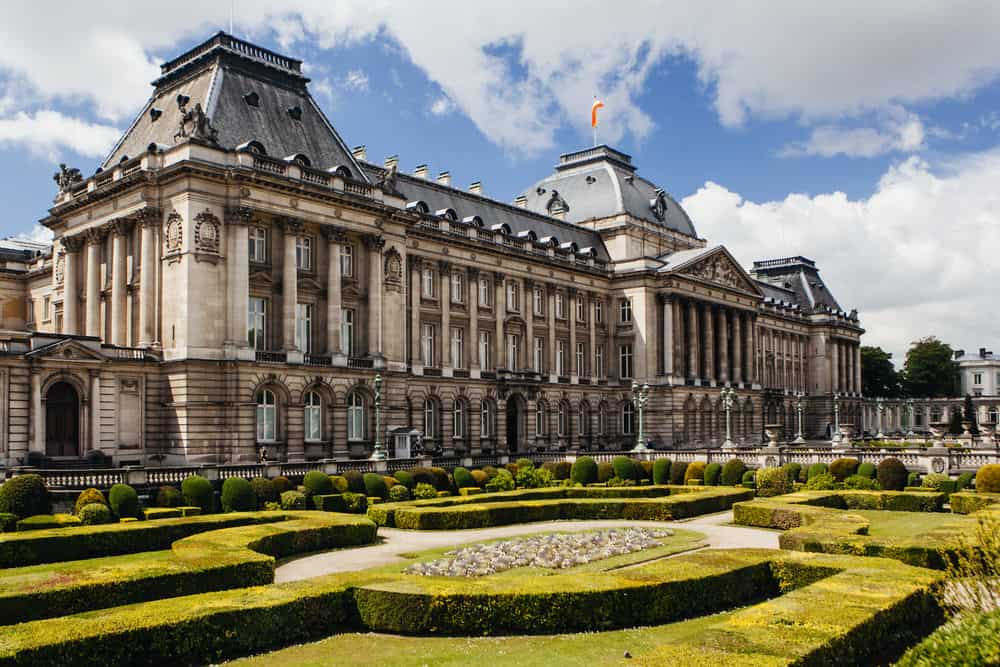
The Royal Palace of Brussels, situated in the heart of Brussels, Belgium, is a magnificent testament to the grandeur of neoclassical architecture. Built during the 19th century, it symbolizes the nation’s rich history and the enduring monarchy. Commissioned by King Leopold II of Belgium, the Royal Palace was meticulously designed to showcase the splendor and elegance of the neoclassical style. The Royal Palace is primarily used for official functions and state affairs. The Royal palace of Brussels is the official palace (not residence) of the King of the Belgians and from which state affairs are handled. The palace provides a dignified setting for important national events, such as state visits, diplomatic receptions, and royal ceremonies. The palace’s interior is not open to the public regularly; during the summer months, visitors can explore a selection of its lavishly decorated rooms. This special occasion allows guests to marvel at the palace’s rich furnishings, remarkable artwork, and exquisite craftsmanship.
About the Royal Palace of Brussels:
- Where: Brussels, Belgium
- When: 19th century
- Who built it: King Leopold II of Belgium
- Style: Neoclassical architecture
- What is it now? No longer the private residence of the sovereigns
- Current owner: Belgian State
33. Royal Palace of Laeken

The Palace of Laeken or Castle of Laeken is the official residence of the King of the Belgians and the Belgian royal family. It lies in the Brussels-Capital Region, 5 km (3 mi) north of the city center, in Laeken (part of the City of Brussels), and sits in a large private park called the Royal Domain of Laeken. The palace was built between 1782 and 1784 for the Governors of the Habsburg Netherlands and was originally named the Palace of Schonenberg. It was partly destroyed by fire in 1890, after which it was rebuilt and extended. Significant modifications were undertaken at the beginning of the 20th century during the reign of King Leopold II. It is often referred to as the Royal Palace of Laeken or the Royal Castle of Laeken. The Palace of Laeken should not be confused with the Royal Palace of Brussels, in central Brussels, the official palace (not residence) of the King of the Belgians and from which state affairs are handled. It is served by Stuyvenbergh metro station on line 6 of the Brussels Metro. The palace serves as the primary residence of the Belgian royal family, providing a private sanctuary for the King and Queen. The Royal Greenhouses of Laeken are open to the public for three weeks each year during the flowering period, from April–May. The palace is known for its stables, the Chinese pavilion, and the Japanese Tower. The painting studio of Elisabeth of Bavaria, Queen of Belgium, can also be admired.
About the Royal Palace of Laeken:
- Where: Brussels, Belgium
- When: 18th century
- Who built it: King Leopold II
- Style: Neoclassical architecture/Neo-Palladian style
- What is it now? Residence of the Belgian royal family
- Current owner: Belgian State
34. Spontin Castle

Spontin Castle, located in Yvoir, Wallonia, Belgium, has a rich history dating back to the 16th century. Spontin was built in a bend of the Bocq, whose water flows around the castle along some cascading waterfalls. The castle belonged to the noble family of Beaufort (named after a castle near Huy). Between 1266 and 1284, Pierre de Beaufort built the main tower, the castle’s core. In 1288, his son William (Guillaume), nicknamed the “Ardennes,” participated in the Battle of Woeringen. For his bravery in battle, in which Henry VII of Luxembourg was defeated, he was rewarded with the fiefdom of Spontin. Currently, the castle is closed to the public and is now a private property.
About Spontin Castle:
- Where: Yvoir, Wallonia, Belgium
- When: 12th – 16th centuries
- Who built it: Unknown
- Style: Medieval architecture / Renaissance Mosane style / French Renaissance style
- What is it now? Closed to the public
- Current owner: Private ownership
35. Steen Castle

Steen Castle, located in the city of Antwerp, Belgium, has its origins in the Middle Ages. Steen Castle is one of the oldest castles in Europe and, therefore, in Belgium. Also known as Het Steen, the name means The Stone, and the castle is made entirely of stones. Before the castle we see today, some structures were built for protection, but Vikings and other enemies destroyed them. However, the present castle dates back to the early 13th century. The castle, which was part of a larger structure in these centuries, has managed to survive until today. Over the centuries, Steen Castle has witnessed significant historical events and undergone various transformations. Despite its turbulent past, the castle retains its medieval charm and character. Today, it serves as a museum, offering visitors a unique opportunity to explore its historical significance.
About Steen Castle:
- Where: Antwerp, Belgium
- When: 13th century
- Who built it: Unknown
- Style: Medieval architecture
- What is it now? Museum
- Current owner: City of Antwerp
36. Veves Castle

Located in Celles, Belgium, dates back to the 7th century. In the later Middle Ages, the area fell under the control of the Beaufort family, which oversaw the construction of a stronghold here in about 1230. The present castle, in the form of an irregular pentagon and flanked by six round towers of varying size, dates largely from around 1410. Successive restorations modified especially the inner courtyard walls, one of which is lined with a distinctive half-timbered gallery of two levels, and another of which was given a red brick facade in the Louis XV style. Veves Castle is open to the public, allowing visitors to explore its fascinating interior and marvel at its well-preserved features.
About Veves Castle:
- Where: Celles, Belgium
- When: 7th century
- Who built it: Unknown
- Style: Medieval architecture
- What is it now? Open to the public
- Current owner: Belgian State
37. Vianden Castle in Luxemberg
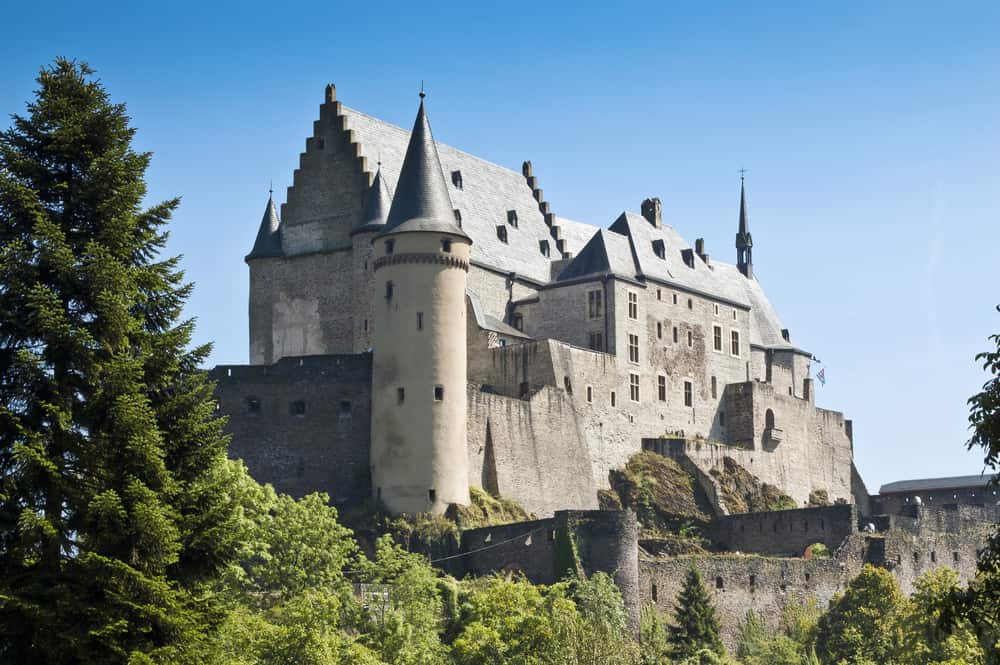
Located in Vianden in the north of Luxembourg, it is one of the largest fortified castles west of the Rhine. With origins dating from the fourth century as a Roman outpost and the 10th century, the more familiar castle form was built in the Romanesque style from the 11th to 14th centuries. A Renaissance mansion was added in the 17th century, but thereafter the castle was allowed to fall into ruins. The castle is open to visitors throughout the year from 10 am to 4 pm every day. In March and October, the closing time is extended to 5 pm, and in the summer months, to 6 pm. Guided tours are also available.
About the Vianden Castle:
- Where: Vianden, Luxembourg
- When: 4th century
- Who built it: Unknown
- Style: Gothic architecture / Romanesque architecture
- What is it now? Open to the public
- Current owner: Luxembourg State
38. Waleffe Castle

Waleffe Castle is typical of the 18th-century houses built in the Meuse Valley. The original owners were the De Corte, or Curtius, one of the most powerful families in Europe, thanks to their ammunition trade. The house subsequently became the property of the de Potesta family, who still own it. Daniel Marot’s famous treaty inspired Louis XIV’s decoration of many rooms. Interesting chapel and vestibule. The interior is homogeneous and gives visitors the feeling that the house is still inhabited. The castle now stands as a private residence.
About Waleffe Castle:
- Where: Faimes, Belgium
- When: 18th century
- Who built it: Unknown
- Style: Medieval architecture / Renaissance architecture
- What is it now? Private property
- Current owner: de Potesta family
39. Westerlo Castle
Locals in Westerlo Castle, located in Westerlo, Belgium, call it “Oud Kasteel” (Old Castle) to discern it from the new castle built for Jeanne de Merode in 1910-12. The castle has been the home of the House of Merode for more than five centuries. The central keep, or Donjon, has walls over 2 m thick. The lords of Wesemael built the local brownstone in the late 14th century. Other parts of the building are believed to date from the 15th and 16th centuries. The castle was adapted, extended, and renovated several times. From the 16th century onwards, it was transformed into a more luxurious noble dwelling and gradually lost its fortified character. Several restorations in the 19th century gave it back a more ‘romantic’ medieval appearance. The church used the building as a home for retired priests until it was sold to the municipality of Westerlo in the 1970s. It has served as the Town Hall of Westerlo ever since.
About Westerlo Castle:
- Where: Westerlo, Belgium
- When: 14th century
- Who built it: Unknown
- Style: Medieval architecture / Renaissance architecture
- What is it now? served as the Town Hall of Westerlo ever since
- Current owner: Private ownership
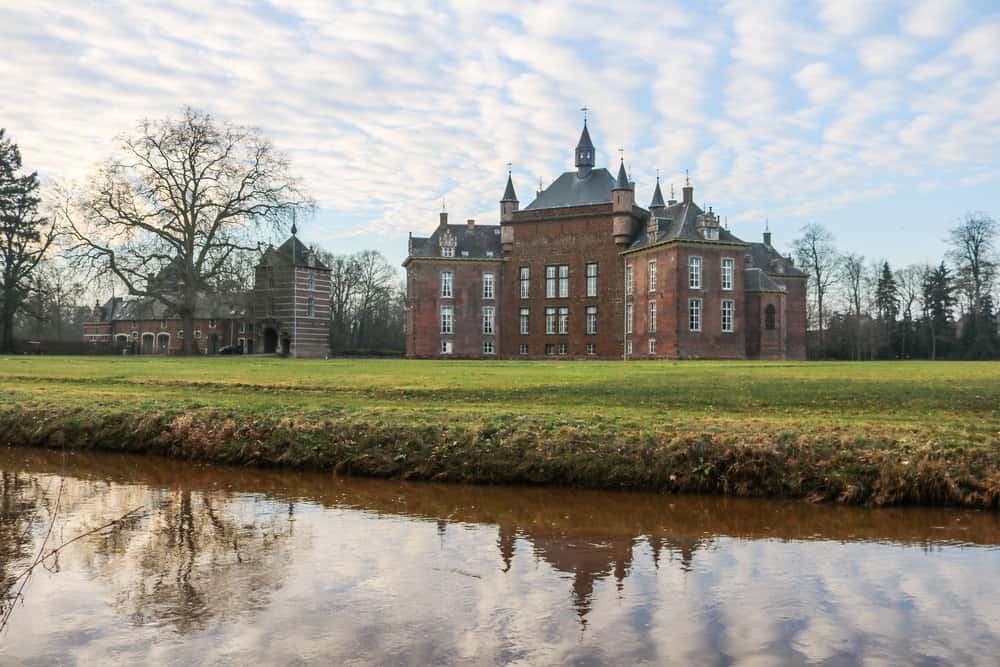
40. Wijnedale Castle
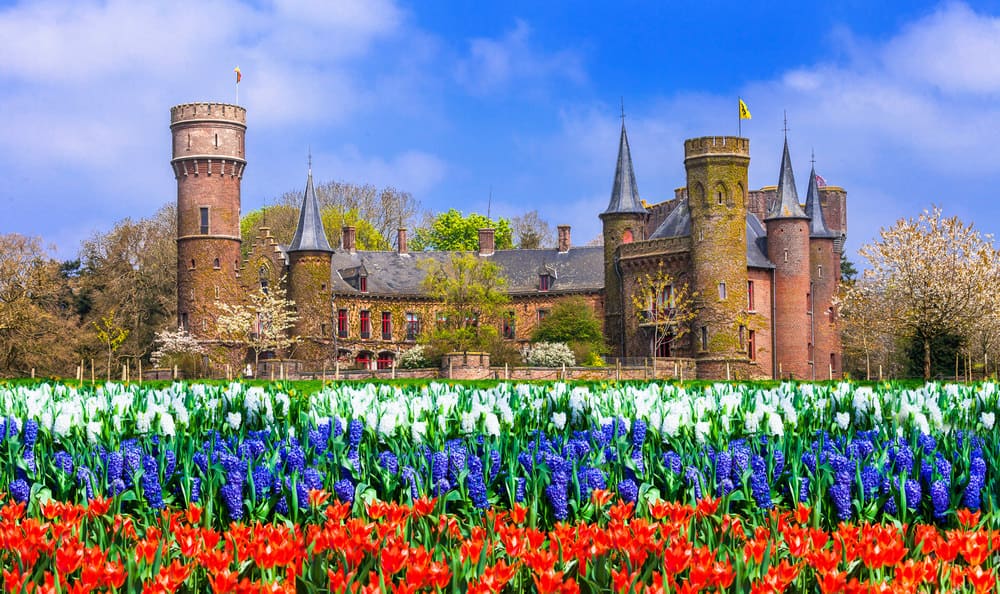
The first castle was built by Robert I, Count of Flanders, at the end of the 11th century and used as a base for military operations. In the 12th and 13th centuries, Wijnendale became a regular residence for the Counts of Flanders and for Philip, Count of Flanders, in particular. In 1297 Guy of Dampierre signed a treaty with the English King Edward I. In 1298 Wijnendale was inherited by the Counts of Namur and besieged and damaged in 1302 and 1325. It is probable that Blanche of Namur grew up here and that it was here that she met her future husband, Magnus IV of Sweden, in 1334. The present owners of the castle currently inhabit one wing, while another is open to the public as a museum.
About Wijnedale Castle:
- Where: Wijnendale, West Flanders, Belgium
- When: 15th century
- Who built it: Robert I, Count of Flanders
- Style: Medieval architecture / Renaissance architecture
- What is it now? Open to the public / Private ownership
- Current owner: Jean-Jacques Matthieu de Wynendaele
Related: English Castles | Irish Castles | German Castles | Russian Palaces | French Chateaus | Scottish Castles | Dutch Castles | Polish Castles | Czech Republic Castles | Hungarian Castles | Swedish Castles | Austrian Castles | Mountain-Top Castles | Indian Palaces | Castles in Portugal | Castles in Switzerland | Castles in Japan | Italian Castles | Castles in Romania | Castles in Denmark | Spanish Castles






